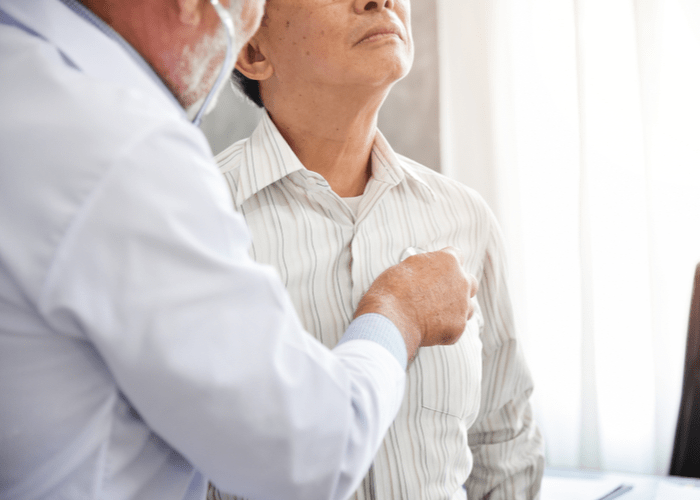
To mark Lung Cancer Awareness Month this November, we’re taking a look at risk factors, symptoms and treatment of lung cancers and the research being carried out by one exceptional Cure Cancer funded researcher.
Although lung cancer occurs mostly in people aged 60 and over, it can affect people of any age or gender. It is responsible for the most cancer-related deaths worldwide and still has a poor survival rate, despite recent advances in therapy.
There are two main types of lung cancer:
- Non-small cell lung cancer (NSCLC) - The most common type of lung cancer, accounting for around 85% of cases
- Small cell lung cancer - Usually begins in the middle of the lungs and spreads more quickly than non-small cell lung cancer
As with all cancers, lung cancer occurs when abnormal cells grow and multiply in an uncontrolled way. Over 13,250 people are estimated to be diagnosed with lung cancer this year. Around 55% of these will be male.
The five year survival rate for lung cancer is 18%.
Risk Factors for Lung Cancer
Anyone can develop lung cancer. However, some risk factors can be controlled, such as lifestyle or environmental risk factors, and others (such as inherited factors) cannot.
Risk factors for developing lung cancer include:
- Tobacco smoking – this is the biggest risk factor for lung cancer, increasing for those who began smoking at a young age, smoked for longer and smoked more often
- Exposure to secondhand smoke (passive smoking)
- Exposure to asbestos, air pollution and other chemicals
- Increasing age
- Family history of lung cancer
- A history of chronic lung disease or other cancers
Symptoms of Lung Cancer
Most lung cancers don’t cause symptoms until they have spread, but some people with early lung cancer do have symptoms. These may include:
- Shortness of breath
- Hoarse/croaky sounding voice
- Chest pain
- Coughing up blood
- Persistent coughing
- Recurring infections such as bronchitis or pneumonia
- Enlarged fingertips
- Loss of appetite/unexplained weight loss
- Fatigue
If lung cancer is found at an earlier stage, there is more chance of a better outcome. If you are experiencing symptoms, it doesn’t necessarily mean you have lung cancer, but it’s worth getting checked out by your doctor.
Diagnosing Lung Cancer
If lung cancer is suspected, doctors will carry out a number of diagnostic tests. These may include:
- Chest X-rays - likely to show up larger tumours
- CT scan - x-rays to take multiple pictures of the inside of the body, able to detect smaller tumours
- Lung function test - used to check how well your lungs are working
- Biopsy - a small sample of tissue is taken for testing in the lab
- Sputum cytology - mucus from the lungs is examined under a microscope to check for abnormal cells
If lung cancer has been diagnosed, the doctor may recommend a PET scan in order to stage the lung cancer. This involves the injection of a small amount of radioactive solution to show up cancer cells.
How is lung cancer treated?
Lung cancers may be treated with surgery/ This is best suited to early stage NSCLC and rarely suitable for small cell cancer. Other therapies include radiation therapy, chemotherapy, thermal ablation, immunotherapy of a combination of treatments. Thermal ablation is typically use for stage 1 non-small cell lung cancers and involves inserting needles into the cancer and destroying them with heat.
Doctors will select the best course of treatment, taking into account the type of lung cancer, how advanced it is and the patient’s general health.
Lung Cancer Research in Australia
Dr Mark Adams – A brighter future for lung cancer patients
Based at the Queensland University of Technology, Dr Mark Adams’ current area of research is lung cancer. Non-small cell lung cancer (the most common form of the disease) is usually treated with chemotherapy or a combination of chemotherapy and radiotherapy.
“Chemotherapy functions by attacking the genome of tumours, but the main issue with this approach is that only twenty to thirty percent of patients respond,” Explains Mark. “So we need new tests to identify which patients are most likely to benefit from certain therapies, and new agents to enhance the effectiveness of current drugs.”
His Cure Cancer-supported research is focused on this quest, in particular on studying novel molecules involved in the stability of genomes (the genetic material of organisms) that will serve as ‘predictive biomarkers’ to identify patients who will best respond to therapy, and molecules that can form the basis of potential future drugs that will make chemotherapy more effective.
He has already identified promising proteins that might help determine the patients best suited for chemotherapy, and is investigating whether combining chemotherapy with new drugs that target proteins involved in tumour growth can improve responses.
In his ongoing Cure Cancer-supported work, Mark is collaborating with international lung cancer experts to assess biopsies from patients who have had chemotherapy. In these biopsies he is correlating levels of proteins involved in cell division with how patients respond to treatment, with a view to using the findings as a clinical tool. He is also publishing some of his findings in international journals.
The end result, he believes, will be better outcomes for patients. He has recently patented his research with a view to helping ensure his discoveries have clinical benefit.
To support life saving lung cancer research like Dr Mark Adams’, please make a donation today. Donate.
If you are experiencing shortness of breath, chest pain, coughing, fatigue or other symptoms that may be related to your lungs, especially if you’re a smoker, don’t ignore the signs. Book an appointment to see a doctor to get yourself tested. The fastest and easiest way to book healthcare online is with MyHealth1st.
Resources:
https://www.canceraustralia.gov.au https://www.aihw.gov.au